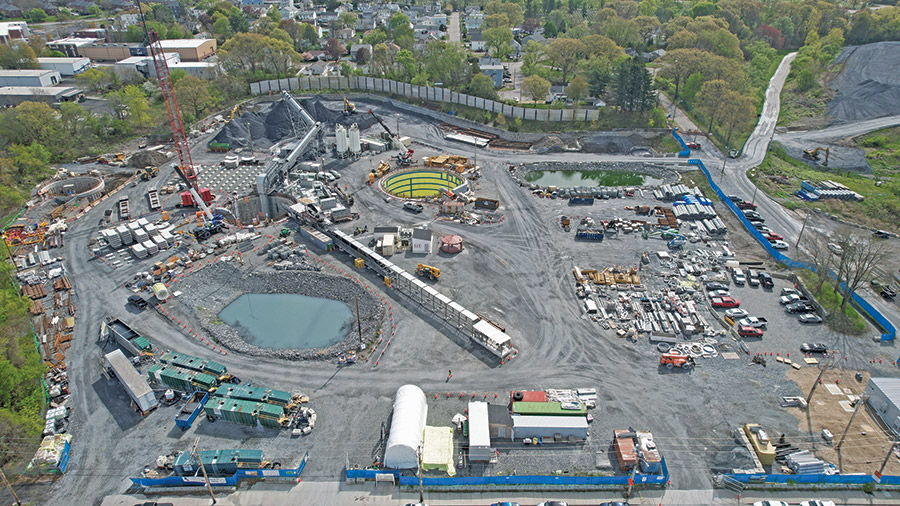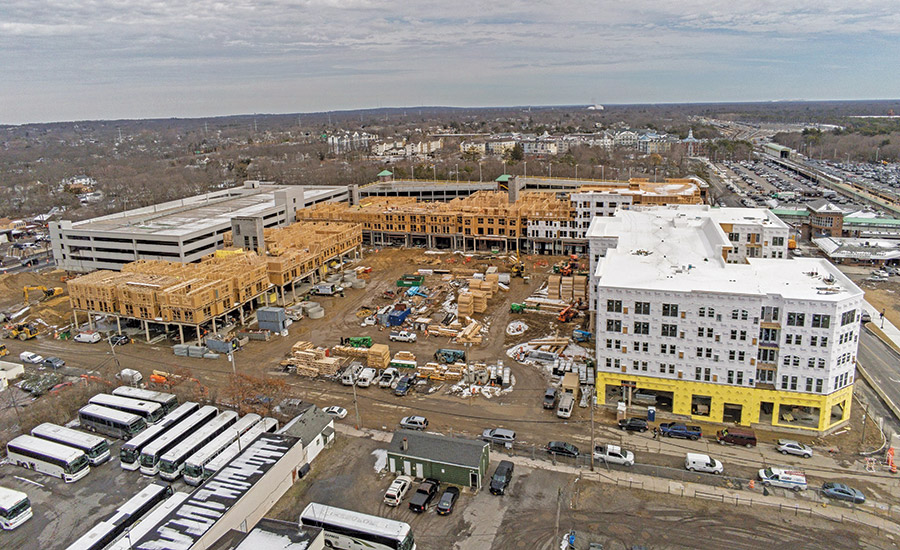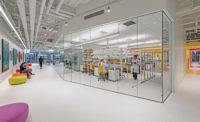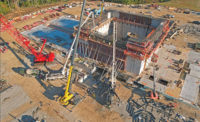Related Links:
ENR New York Top Design Firms 2023 Rankings
ENR New England 2023 Top Design Firms Rankings
Some regional designers may want to shout it from the top of Boston’s Prudential Center and New York City’s Empire State Building: Northeast design firms ranked by ENR New York and ENR New England closed out 2022 by finally surpassing the list’s pre-pandemic regional revenue total.
the first time since COVID-19 started in 2020, firms participating in the magazine’s two regional Top Design Firm surveys pushed their combined revenue beyond its level in 2019.
The 98 New York and New Jersey firms listed on the 2023 ENR New York ranking combined to report $5.88 billion in 2022 revenue. The 2020 survey—based on 2019 revenue—totaled $5.66 billion. This year’s New York total represents a 9.74% increase from last year, when 95 companies were ranked on the overall regional Top Design Firms list. Revenue in 2021 was 6.7% higher than the $5.04 billion reported by the top 95 firms for 2020.
In New England, overall design revenue from firms performing work in Connecticut, Maine, Massachusetts, New Hampshire, Rhode Island and Vermont also surpassed pre-pandemic levels for the first time. The top 59 firms on this year’s ranking logged a combined $2.58 billion in regional revenue. On the 2020 ranking, based on 2019 data, 59 firms reported a total of $2.4 billion in regional revenue. This year’s total represents a 16.22% hike in revenue compared with last year, when the top 59 firms reported $2.22 billion.
Upper Crust
After a collective decline last year, the 10 highest ranking firms on each survey posted revenue increases on this year’s lists. The top 10 firms in the New York region said revenue rose 16.7% to $2.8 billion, compared with $2.4 billion last year. This year’s total also exceeded pre-pandemic levels, when the 10 highest-ranking companies posted 2019 revenue of $2.7 billion.
New England’s 10 highest-ranked firms posted $1.3 billion in combined revenue, 8.33% higher than the $1.2 billion posted last year. It also equals the $1.3 billion reported by the top 10 firms in 2019.

Stantec, ranked No. 4 on the ENR New England Top Design survey and No. 10 on the New York ranking, is serving as lead designer and program manager for the Narragansett Bay Combined Sewer Overflow Program Phase III (Pawtucket Tunnel Construction) project.
Photo courtesy CB3A (Joint Venture)
Win, Place and Show
The top three firms on this year’s New England ranking—AECOM, VHB and WSP USA—are well above both pre-pandemic revenue levels and last year’s figures. The $227.13 million reported by AECOM is a 6.20% increase from last year’s $213.86 million. After ranking No. 3 the last two years, VHB jumped into second position with $191.22 million, up 18.77% from $161 million in 2021.
WSP USA moves up a slot this year to No. 3 with $184.60 million, a 41.49% increase from last year’s $130.46 million. Reporting $167.93 million, Stantec fell two spots to fourth place despite the 3.45% increase in revenue from last year’s $162.32 million.
The top three slots in New York and New Jersey go to AECOM, WSP USA and Gensler.
Of those firms, AECOM is the only one that surpassed pre-pandemic levels on the 2023 survey. The company’s $614.96 million in revenue is a 7.63% increase from last year’s $571.37 million and is up 0.51% from its 2019 total of $611.84.
WSP is once again second on the New York list with $472.13 million, an 11.2% increase from last year’s $424.57 million. Gensler moved up three spots on the list to No. 3 with $285.03 million in revenue, a noteworthy 63% increase from last year’s total of $174.80 million.
Hot Sector
The energy sector continues to be a shining star in New England revenue production for design firms.
According to survey data, the top 10 firms in the energy sector reported $258.52 million in revenue, a 71.98% increase from last year’s $150.32 million. Despite lingering pandemic impacts, last year’s figure was itself a 11.3% hike from the previous year. TRC Cos. leads the sector on the 2023 list with $58.28 million in revenue. The firm ranks sixth on the overall New England survey with $95.39 million.
The top 10 firms in New York and New Jersey’s energy sector collected $280.38 million in 2022 revenue compared with $240.05 million reported in 2021, a 16.8% boost. Burns & McDonnell, ranked No. 14 overall on the New York region ranking with $136.29 million, leads the energy sector with $75.62 million.
The transportation sector in New York and New Jersey also is starting to bounce back. Top 10 firms on last year’s sector ranking reported a 10% revenue drop compared with the previous year, when $1.42 billion was recorded. This year, the top 10 firms in transportation saw a 4.23% increase to $1.48 billion.
Interviews with regional design firm executives in New England and New York-New Jersey shed further light on industry performance and market expectations for 2023 and beyond. The responses of interviewees have been lightly edited for length and clarity.
What lessons from the last few years have most shaped the way you do business now?
Richard Humann, president and CEO at H2M: Our business diversity has always been a strength for us, and the model was really validated over the past few years. We provide a multitude of engineering service offerings to various market sectors. The pandemic caused tremendous uncertainty, and clients in major market sectors either reduced or cancelled projects as a reaction. Fortunately, we were also providing services to market sectors that were still thriving.
Over the course, we were able to maintain our staff investment and continue to grow, although at a lower pace. As a result, we are focused on strengthening our market and geographic diversity as a primary means of combatting economic headwinds.
Tom Walsh, vice president and Northeast regional leader at Stantec: We continue to invest in our people by focusing on employee engagement and work-life balance and providing workplace flexibility. Remote work and collaboration have increased our global view and connectivity, and we see this trend continuing.
Which sectors have offered the biggest opportunities in the region(s)?
Humann: The energy, water, wastewater and municipal infrastructure markets are very active in the region. As the federal infrastructure funding makes it way to state and local governments, low interest financing and grant programs should be expanded and funded for the next 5 – 10 years. Renewable energy goals are driving significant commitment to wind and solar energy. Water quality and emerging drinking water standards are causing community systems to invest in new advanced treatment technologies. Aging infrastructure in roads, bridges, water and wastewater continue to be a priority investment area for governments and municipalities.
Walsh: Improving climate outcomes remains top of mind for our clients, with continued growth in renewable energy (solar, on- and off-shore wind, and grid improvements), coastal resiliency, ecosystem restoration, and the development of agricultural and bio-industrial products, including sustainable fuels and building products. Ongoing work at the Portsmouth Naval Shipyard and other facilities down the coast is driving business with our federal clients, while infrastructure and transit-related opportunities are also on the rise, with significant recent wins in projects aimed at restoring community connectivity. Our institutional (healthcare and education) work also remains strong.
Which sectors have cooled down in the region?
Humann: Retail and commercial development has slowed, primarily as a result of the pandemic. Businesses that have adopted full or hybrid work-from-home strategies have caused some depression in the commercial office market. Changes in consumer habits have clearly affected retail. I believe the opportunity now presented is the repurposing of retail land commercial spaces. As part of that, local governments and zoning regulations need to be assessed. The regions that innovate well will be able to pivot away from the sagging effect of existing retail and commercial real estate.
Walsh: While some sectors are hotter than others, we haven’t seen any significant cooldowns outside of commercial and workplace, which remain slower following the pandemic.
What key innovations helped you boost productivity or other metrics in the region(s)?
Humann: Leveraging technology over the past three years has been vital–and essentially non-negotiable. In the early stages of the pandemic, productivity was clearly negatively affected, either due to projects being paused or cancelled, and the challenge of working as project design teams remotely. However, out of the challenge came the opportunity to embrace collaborative design tools and software, allowing design teams to work together with design documents and share review/coordination efforts, especially in multi-discipline design projects.
Walsh: Our teams continue to utilize emerging technologies to improve internal efficiency and collaboration while addressing unique challenges for our clients.
How do you think the market will perform in your region during the next year or two?
Humann: The current economic conditions have not yet had a negative impact on the markets in the region. I believe the markets will remain strong over the next year or two. Funding at all levels of government will be primary drivers of market growth and success. The caution is in how stable the economy remains over this time. Although it has not had a meaningful affect, the risk remains so that optimism should be the outlook, but with a strong awareness of economic trends.
Walsh: The market will remain strong but innovation and creative solutions will be required to address continued supply chain and funding concerns. For example, many agencies that administer funding are facing resource shortages, which could open opportunities for firms to provide owner’s advisor or staff augmentation services to help reduce bottlenecks in dispensing funds. We are also seeing an increase in alternative project delivery vs. traditional design-bid-build.





